Simple and double superphosphate - the use of fertilizer in the garden and vegetable garden: instructions, composition, features of use
Probably every summer resident has heard of superphosphate, perhaps you even used it in your area. But did you do it correctly, so to speak, "in science"? Let's figure it out!
In this material you will find answers to basic questions regarding the use of superphosphate in the garden and vegetable garden, dosages, methods of using and preparing an infusion solution (extract), varieties and their differences.
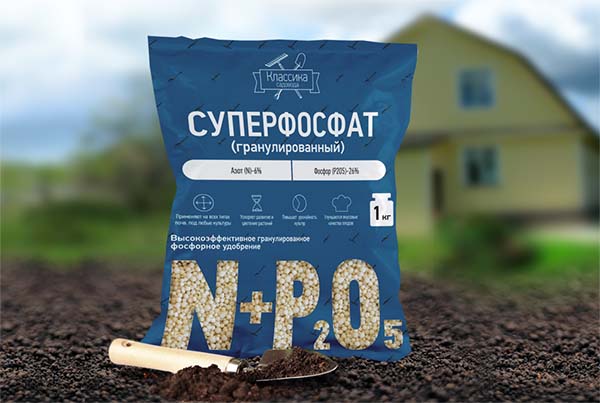
Content
What is superphosphate: chemical composition and scope
Superphosphate is the most popular mineral phosphate fertilizer.
Note! Superphosphate is not a purely phosphorus fertilizer (phosphorus P2ABOUT5): it always contains nitrogen (N), as well as other meso- and microelements (most often sulfur, calcium, magnesium).
It should be understood that superphosphate is no not chemistry! is he made from natural minerals (apatitov), which are a natural product of geological processes (not chemical).
Superphosphate of any kind, usually, looks about the same - this gray granules... But sometimes white granules are also found.
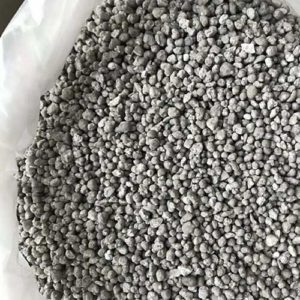
By the way! About, why are phosphorus fertilizers (including superphosphate) needed (what are the benefits of them for plants), detailed in this material.
What to use for
Superphosphate is a universal fertilizer for all crops on all types of soils, respectively, it can be used:
- when preparing the soil in autumn and in the spring;
- when planting fruit trees and berry bushes, ornamental plants and flowers, the same bulbous and tuberous (added to the planting pit and must be mixed with the soil), laying a lawn;
- when planting seedlings in open ground or in a greenhouse (added to the hole and mixed with the soil);
- for feeding all garden and horticultural crops during the entire growing season (an infusion solution is made or they also say "extract").
Storage conditions and shelf life
- You need to store in a closed and dry roomprotected from precipitation. Out of the reach of children and pets. Separated from food, medicines, pesticides. Joint storage with paints, solvents is not allowed, lubricants and cleaning materials, sawdust, peat.
- Shelf life is not limited... However, guarantee period - from 2 to 5 years.
When and how to use superphosphate in the garden and vegetable garden: methods and rules of fertilization
Timing and methods
Superphosphate always bring under the root (in the trunk circle plants), i.e. do root dressing in dry or liquid form.
Phosphates are almost not absorbed through the leaf, so foliar feeding on the leaves (spraying) does not make much sense.
However, after flowering (one month before harvest), many recommend spraying the tops of potatoes with phosphorus. Such foliar dressing improves the maturation of tubers, increases their starchiness, and reduces the incidence of diseases.
As for how best to do such feeding - in dry or liquid form, it all depends on the purpose and timing of introduction:
- If you need urgently feed the plant (in spring, summer or even autumn), then only in liquid form (and it is desirable to prepare a special solution-infusion, the recipe for which will be given in a separate paragraph).
- If you add superphosphate in the fall in the calculationso that it becomes fully available to plants only next season, then, naturally, - dry, for example, on a garden bed for digging (plowing or loosening) or a plant's trunk circle (with subsequent embedding).
By the way! The site has a separate detailed article about what fertilizers are best applied in the fall to the soil for digging to restore fertility.
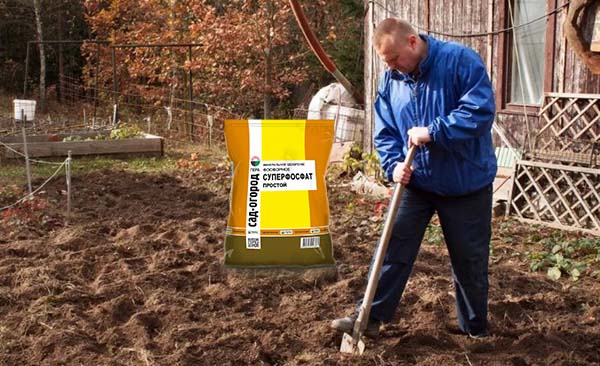
It is worth understanding! Naturally you you can add superphosphate dry when preparing the garden bed, in the near-trunk circle of the plant, or in the hole (planting hole), when planting it or planting seedlings (while fertilizer must be mixed with soil), and in the spring.
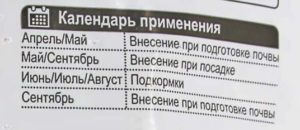
However, efficiency will be much lowerthan with autumn application or liquid feeding.
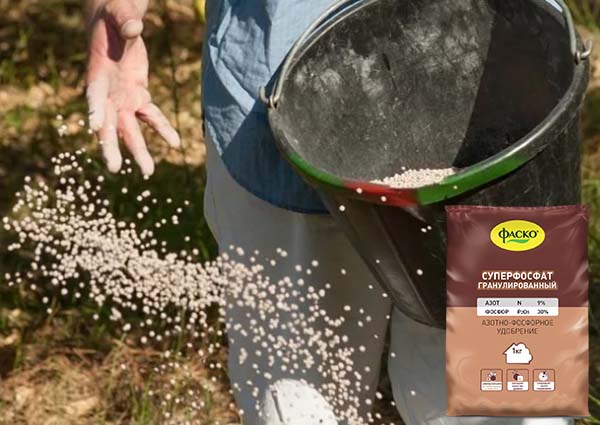
rules
- Not recommendedmix (apply simultaneously) superphosphate from soil deoxidizers (which reduce its acidity), i.e. from wood ash, dolomite flour, lime. This will lead to the fact that some of the phosphorus will become insoluble and inaccessible to plants.
Therefore, between these two processes (the introduction of phosphorus fertilizer and deoxidizer) you need do an interval (at least 4-6 months, preferably a year).
- The same applies to the simultaneous application of superphosphate and calcium fertilizers (for example, calcium nitrate).
- Some sources indicate that it is not recommended to mix simple superphosphate with nitrogen mineral fertilizers (urea, ammonium nitrate).
However, this only applies to powdered superphosphate, and the granular version can be mixed.
Interesting! Have you ever seen powdered simple superphosphate on sale?
- Despite the fact that superphosphate can be used on all types of soils (optimally - on neutral), for example, simple superphosphate will work more efficiently on more alkaline, and double superphosphate - on more acidic soils (the same weakly acidic).
Dosage
For calculated dosages for fertilizing and feeding various crops, see the package (in the instructions). Have different manufacturers content nutrients (phosphorus and nitrogen) can differ, accordingly, the consumption rates will be adjusted.
Advice! However, do not be afraid to overfeed the plant with phosphorus: this cannot be done, because it takes from the soil only as much phosphorus as it needs. But still, what is the point of spending more fertilizer (= money) if a greater effect is not achieved?
- Example instructions by application simple superphosphate:
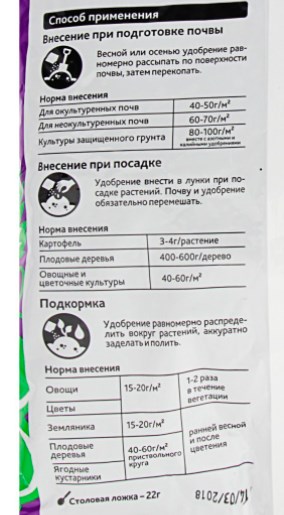
- Example instructions by application double superphosphate:
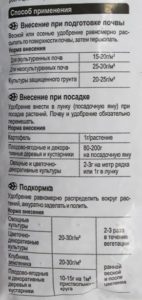
Approximate dosage measures for granular superphosphate:
- a teaspoon - 5-6 g;
- a tablespoon - 15-20 g;
- matchbox - 20-26 g;
- glass - 200-260 g.
Rapidly assimilated feeding with superphosphate
So, you can make a "quick" liquid feeding of a superphosphate solution in 2 ways:
This top dressing is also called "superphosphate extract".
1 way
- Dissolve 100 grams of superphosphate (preferably double) in 1 liter of boiling water, let it brew for 12-24 hours, stirring occasionally, dilute 1 to 10 with water (i.e. mix with 10 liters of water) and pour under the root.
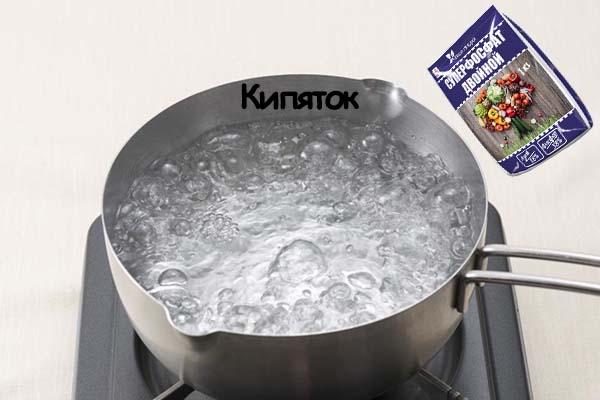
2 way
If you want to make an even more effective and easily digestible top dressing with superphosphate, then it is better to prepare the following infusion-extract (again, a desirable double):
- 1 kg double superphosphate pour 5 liters of boiling water;
- After the water has cooled, add 0.5 liters of 9% vinegar;
Acidification of water with acetic acid will help convert calcium phosphate to a more soluble form.
- Let it brew for 12-24 hours (for example, you can leave it overnight), periodically shaking and stirring.
- Add another 5 liters of water, bringing the total volume to 10 liters.
- Then dilute 1 liter of the superphosphate infusion with 10 liters of water (1 to 10), i.e. you end up with 100 liters of phosphate fertilizer.
Accordingly, if you do not need such an amount of fertilizer (as much as 100 liters), then simply reduce its initial concentration (5-10 times), for example, taking not 1 kg of double superphosphate, but 100-200 gr. and proportionally reduce the amount of vinegar to 50-100 ml, as well as water to 1-2 liters.
- Carry out top dressing.
Advice! The infusion will do for feeding strawberryas well as others berry bushes (gooseberries, currants), a remaining after him phosphorus precipitate can dig under fruit trees (apple, pear, plum, apricot) or bring under digging (loosening) on vegetable beds.
Video: effective feeding of strawberries with superphosphate in an easily digestible form
Varieties of superphosphate (simple, double, huminized and ammoniated): their differences and compositions
Perhaps superphosphate is the most popular phosphorus fertilizer, which comes in the following varieties:
Simple superphosphate
Sometimes they also say "granular" superphosphate.
Structure: 20-29% phosphorus and 6-9% nitrogen.
And also on average 8-12% calcium (maximum up to 16-20%), 8-10% sulfur (maximum up to 10-15%) and 0.5% magnesium (maximum up to 1-2%).
Typically, simple superphosphate is used for dry top dressing = embedding in soil (digging, loosening).
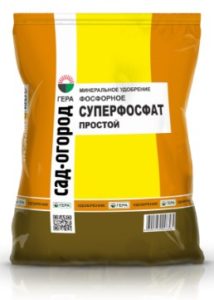
On sale sometimes you can find enriched simple superphosphate.
Composition: 20% phosphorus, 19% nitrogen, 2% magnesium, 0.5% manganese, 0.2% zinc, 0.2% boron, 0.2% copper, 0.2% molybdenum, 0.1% cobalt.
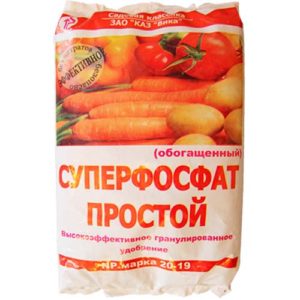
Double superphosphate
Contains: 38-49% phosphorus and 6-12% nitrogen.
It also contains calcium and sulfur (but much less than simple, i.e. almost no gypsum), iron and aluminum phosphates.
Liquid feeding (solution-infusion or extract) it is made from double superphosphate.
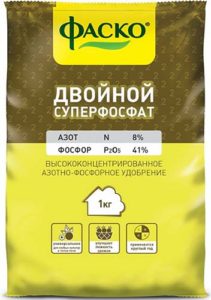
Have different manufacturers content nutrients (nitrogen and phosphorus) can insignificantly differ... For example, in simple superphosphate from the manufacturer "Hera" - 26% phosphorus and 6% nitrogen, in double - 40% phosphorus and 8% nitrogen. The manufacturer "Fasco" in a simple - 30% phosphorus and 9% nitrogen, and in double - 41% and 8%.
Ammonized: simple and double
Usually, in simple ammoniated - 30% phosphorus and 9% nitrogen, and in double - 46% and 8-9%.
In addition to phosphorus and nitrogen, ammoniated superphosphate contains at least 1.6% ammonia, as well as calcium and sulfur.
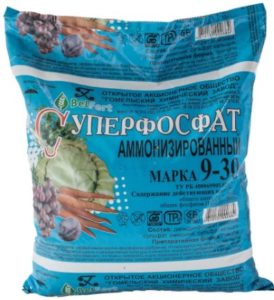
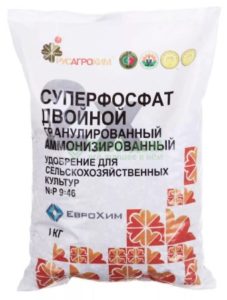
Humanized simple
Fertilizer contains not only phosphorus and nitrogen, but also increased content magnesium and calcium + some amount humic compounds.
Composition: 26% phosphorus, 5% nitrogen, 8% magnesium, 7% calcium, 5% sulfur and 0.02% humic compounds.
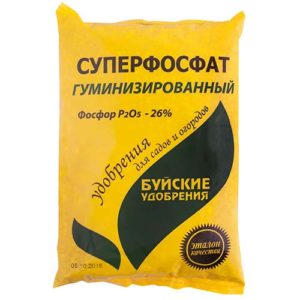
How simple superphosphate differs from double
- Production method and the final composition (amount of phosphorus).
So, simple superphosphate is obtained from phosphorites by processing them sulfuric acid... Whereas double superphosphate is obtained from phosphorites by processing them orthophosphoric acid or phosphoric acid.
The main difference double superphosphate from simple - lower content of gypsum (sulfur) and as a consequence, higher phosphorus content.
Which superphosphate is better and more profitable to use - simple or double
The answer here is unambiguous - double. First, it has a higher phosphorus content, i.e. there is no ballast in the form of gypsum (sulfur), and secondly, the price of a double is by no means 2 times higher than that of a simple one, but as a rule, only by 25-30%, while it needs to be applied 2 times less.
So, in November 2019, in the Leroy Merlin store, the price of double superphosphate was 56 rubles per kilogram, for a simple one - 44 rubles.
As a result, it is double superphosphate that has the most optimal ratio in terms of price and quality (amount of phosphorus).
However, gypsum still dissolves in water (albeit poorly), which means that in simple superphosphate there is also sulfur (a useful nutrient for all crucifers, the same cabbage, legumes, as well as potatoes, tomatoes and cucumbers).
Well, now you know how to use superphosphate correctly, and this is very useful knowledge, because superphosphate is part of the main fertilizer, which every summer resident should have if he wants to get bountiful harvests of vegetable, berry and fruit crops annually.


Thank you, very useful information. Everything is laid out on the shelves, sensibly. I will use your information.
Dissolve 100 grams of superphosphate (preferably double) in 1 liter of boiling water, let it brew for 12-24 hours, stirring occasionally, dilute 1 to 10 with water (i.e. mix with 10 liters of water) and water at the root.
QUESTION - HOW MANY OUT OF 10 L OF SOLUTION PER 1 ADULT TREE?
Good day! From 30 to 50 liters of working solution (it is optimal to shed it along the perimeter of the crown or near-trunk circle, and not at the root).